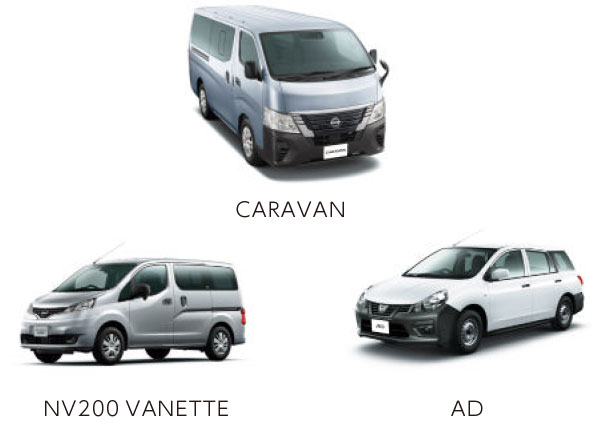Product Development
Improving Fuel Efficiency
Improving fuel efficiency constitutes the competitiveness of the products, which are vehicles, and at the same time is the social demand imposed on us from the perspective of the conservation of limited global resources. A wide range of technological innovations are necessary for these improvement activities, including alternative energy compatibility and combustion technology development, as well as development of the materials for making cars lighter, making drive-trains highly efficient, reducing air resistance, etc.
Outcomes of the activities
With the goal of improving the environmental performance of development vehicles, Nissan Shatai is complying with strict CO2 emissions regulations while continuously advancing the development of products with outstanding fuel efficiency performance.
The Caravan is a diesel vehicle which, depending on the grade, has achieved the “fiscal 2022 fuel efficiency standard,” “95% of the fiscal 2022 fuel efficiency standard" or “90% of the fiscal 2022 fuel efficiency standard.”
The NV200 Vanette Van 2WD has achieved “105% of the fiscal 2022 fuel efficiency standard” and the AD 2WD has achieved “100% of the fiscal 2022 fuel efficiency standard.”
Exhaust gas cleaning
We are aiming to deliver as many environmentally-friendly clean exhaust gas vehicles as possible to our customers. For that reason, we are collaborating with Nissan Motor to stipulate voluntary target values, and are actively tackling technology development and commercialization.
Promotion of product development for realization of an environmentally-friendly vehicle society
Nissan Shatai, which consistently manages development, manufacturing, and product guarantees, has set the environmental goal of “promotion of commercialization conforming with voluntary standard values stricter than the exhaust gas regulatory values stipulated in the law” and is constantly advancing product development based on the Nissan Green Program, which considers the four issues of “climate change,” “air quality,” “resource dependency” and “water resources” to be the important issues.
Initiative to expand commercialization of low exhaust gas vehicles
In order to provide more environmentally-friendly vehicles at more affordable prices and to introduce exhaust gas cleaning technology to as many of our vehicles as possible in order to meet the demands of society, we are working toward the goal of acquiring low exhaust gas vehicle certification for the vehicles we sell domestically.
Regarding production vehicles in Nissan Shatai, in the WLTC mode* the NV200 Vanette Van 2WD, AD 2WD, and Elgrand vehicles have all achieved the 2018 standard exhaust gas 50% reduction level. The NV200 Vanette Van 4WD, AD 4WD, and Caravan vehicles have all conformed with the 2018 standard exhaust gas regulations.
* WLTC mode is an international driving mode comprised of the average use time allocation for each driving mode: “city,” “suburb” and “high-speed road.”
City mode: anticipates comparatively slow driving impacted by traffic lights and traffic congestion, etc.
Suburb mode: anticipates driving which is not impacted much by traffic lights, traffic congestion, etc.
High-speed road mode: anticipates driving on high-speed roads, etc.


Reduction and improvement of the recyclability of environment-impacting substances
In order to encourage the recycling of cars as a part of the efficient circulation of resources, it is necessary to design new model vehicles while considering from the design stage what happens to the vehicles after they have been used. For that reason, we are advancing the improvement of material aspects, including restrictions on the use of substances which have a marked impact on the environment and the active adoption of materials which can be recycled easily, etc.
Reduction of environment-impacting substances
Based on the global policy of Nissan Motor, we ascertain and manage the chemical substances contained in our products and are advancing the elimination of the following kinds of environment-impacting substances.
Reduction of heavy metal compounds (lead, mercury, cadmium, hexavalent chromium)
Lead: Eliminated (some exclusions including batteries, electronic circuit boards and electrical application solder, etc.)
Mercury: Elimination completed (some exclusions including discharge headlamps and fluorescent lamps for displays). Furthermore, we have eliminated cadmium.
Hexavalent chromium: Eliminated (some territories excluded but in these cases (North America, general exports, etc.) Nissan has set its own targets and is working to reduce use).
Reduction of specified bromine flame retardants , etc.
Specified bromine flame retardants (pentabromodiphenyl ether, octabromodiphenyl ether): Elimination completed.
Reduction of VOCs (Volatile Organic Compounds) inside vehicles
VOCs is the collective term for Volatile Organic Compounds such as formaldehyde and toluene, etc. which are thought to be the cause of irritation in the nose and throat.
In the Caravan, in order to reduce VOCs inside the vehicle, we have reduced the volatilization amount of the seats and door trim, floor carpet, etc. by revising the members and adhesive agents used in them. Furthermore, we have reduced the level of the 13 substances stipulated by the Ministry of Health, Labour and Welfare* to below the indoor concentration guideline values.
* The 13 substances stipulated by the Ministry of Health, Labour and Welfare: the 13 substances which are VOCs (Volatile Organic Compounds) that cause sick car and sick house syndrome for which the Ministry of Health, Labour and Welfare has stipulated indoor concentration guideline values (formaldehyde, toluene, xylene, para-dichlorobenzene, ethylbenzene, styrene, chlorpyrifos, di-n-butyl phthalate, tetradecane, di-2-ethylhexyl phthalate, diazinon, acetaldehyde, and fenobucarb)
Improvement of Recycling Efficiency
With the aim of building a recycling-oriented society, and based on the 3Rs (reduce, reuse, recycle) approach, we have prepared the Recycling Design Guidelines incorporating a variety of improvement proposals for carrying out the design of new model vehicles.
<The 3 Rs>
Reduce: Reducing from the start any materials which will become waste.
Reuse: Reusing used parts as secondhand parts.
Recycle: Using removed parts as raw materials (Recycle)


| Content of the recycling | Response of the Caravan |
|---|---|
| · Adoption of materials which can be recycled easily |
· Promotion of parts design with a single material · Expanded adoption of thermos-reversible resin · Implementation of labels for each material (marking) |
| · Active adoption of the materials of parts collected from the market |
· Utilization of recycled parts from bumpers · Utilization of shredder residue |


Examples of the main parts recycled in the Caravan
